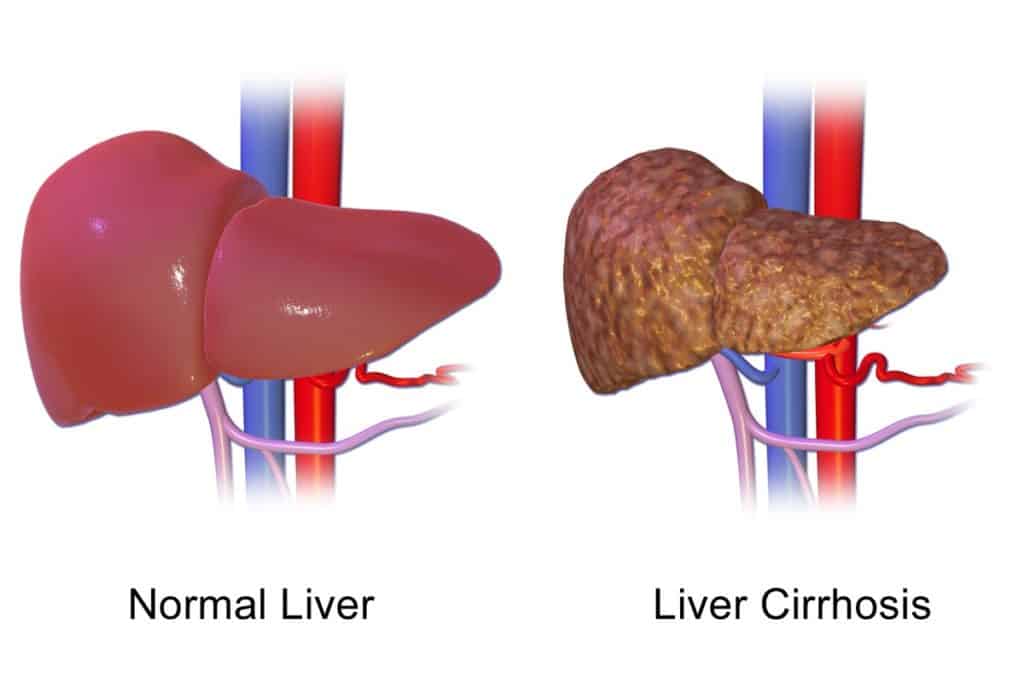Alcoholism Cirrhosis, Its Symptoms, and Drinking with Cirrhosis
As defined by The Mayo Clinic, Cirrhosis is the late-stage scarring (fibrosis) of the liver caused by many forms of liver diseases and conditions, such as hepatitis and chronic alcoholism(1). Someone who continues drinking with cirrhosis isn’t allowing their liver to repair itself, resulting in scar tissue forming, thus making it very difficult for the liver to function. In some cases, advanced cirrhosis can threaten your life or even be fatal. Some people won’t be able to tell they are in alcoholism cirrhosis and can’t decipher alcoholism cirrhosis symptoms. Alcoholism cirrhosis works slowly, but if not dealt with, can lead to complications that stick with you for the rest of your life. So how can you halt the effects of alcoholism cirrhosis and what are alcoholism cirrhosis symptoms?

Alcoholism Cirrhosis
Unfortunately, alcoholism cirrhosis is not an uncommon disease. According to Healthline and the American Liver Foundation, between 10-12 percent of heavy drinkers will develop alcoholism cirrhosis(2). There are many causes as to how someone develops alcoholism cirrhosis. The most obvious is drinking too much alcohol. When you drink more alcohol than the liver can process, the organ become damaged. The chemical reaction your liver has to produce to break down alcohol releases a toxin which in turn damages the cells in your liver. Vast alcohol consumption over a long time will repeatedly damage the liver and make it so it affects your whole body. Other factors can mix in with drinking to develop alcoholism cirrhosis. Being overweight, having a bad diet, your ethnic background (for example, alcoholism cirrhosis rates are higher in African- American and Hispanic males than Caucasian, and women are more vulnerable than men), and having a pre-disposition to hepatitis can increase the chances and damage of alcoholism cirrhosis.
Check Your Insurance Coverage for FREE
Find out if your insurance covers addiction treatment in minutes. We accept most insurance!
Alcoholism Cirrhosis Symptoms & Stages
There are many stages a drinker will go through before they get to alcoholic liver cirrhosis, which is the most advanced kind of liver disease coming from consuming alcohol. It can start with fatty liver disease. This is when fat builds up inside liver cells, making it harder for the liver to do its everyday functions. Usually this stage is symptom free, besides the possible pain on the right side of the stomach from an enlarged liver. Fatty liver disease can turn into alcoholic hepatitis. Alcoholic hepatitis is the killing of liver cells, along with inflammation. This when we start to see fibrosis, the scarring of the liver. Eventually these two stages lead to alcoholism cirrhosis. In some cases, people have skipped the earlier stages and developed alcoholic liver cirrhosis.

Alcoholism cirrhosis symptoms start to spring up in drinkers between the ages of 30 and 40. At first, a body is able to make up for your liver’s inability to work. But as the cirrhosis develops, symptoms are more apparent. Some alcoholism cirrhosis symptoms are:
- Jaundice, the yellowing of the skin and whites of the eyes.
- Portal Hypertension, which is the rising of the pressure in a portal vein. The portal vein carries blood from organs to the liver.
Itching of the skin.
According to the NHS, some other alcoholism cirrhosis symptoms are abdominal pain, loss of appetite, fatigue, and diarrhea(3). There are advanced alcoholism cirrhosis symptoms as well. NHS states them as: swelling in the legs ankles and feet caused by a build-up of fluid (oedema), swelling in your abdomen caused by a build-up of fluid known as ascites, a high temperature and shivering attacks, hair loss, unusually curved fingertips and nails, blotchy red palms, significant weight loss, muscle wasting, confusion and memory problems, trouble sleeping, and changes in your personality caused by a build-up of toxins in the brain, passing black, tarry poo and vomiting blood as a result of internal bleeding, a tendency to bleed and bruise more easily, increased sensitivity to alcohol and drugs and because the liver cannot process them (4).
Drinking with Cirrhosis and Alcoholism Cirrhosis Treatment
Once someone has developed fatty liver disease, alcoholic hepatitis, or alcoholism cirrhosis, the best thing they can do is immediately stop drinking with cirrhosis and stay abstained from alcohol after your health recovers. According to Medical News Today, stopping drinking once diagnosed with fatty liver disease maybe be able to reverse the condition within 2 to 6 weeks(5). For those further in the stages of alcoholism cirrhosis, the conditions that have been corrected from not drinking with cirrhosis will usually return once they start drinking with cirrhosis again. For those who are chronic drinkers, it’s not recommended that you stop drinking without medical support. Stopping drinking cold turkey can be life-threatening. It’s recommended you check into a hospital, detox, or rehab and procure medial help if you are a chronic drinker and want to stop drinking. Medications such as benzodiazephines can ease alcohol withdrawals in someone with an alcohol addiction. Once you have obtained some physical sobriety and your health has returned, you can maintain a life without alcohol through 12-step programs like Alcoholics Anonymous, finding and dealing with root psychological trauam and emotional triggers of your drinking with therapy, and taking medications like acamprostate, naltrexone, topiramte, baclofen, and disulfiram can curve relapses. For those who continue drinking with cirrhosis and ignore the alcoholism cirrhosis symptoms, their liver will completely fail and shutdown. This means a liver transplant is necessary to continue living, and hospitals don’t give out livers to just anybody. A person has to show at least six months of sobriety and a vast change in health before they can be considered for a transplant, which is a complicated procedure that can only happen if someone is willing to be a donor. Even after a successful surgery, there are other things that can go wrong, and it’s not guaranteed to be smooth sailing. It is possible to live a life after going through alcoholism cirrhosis. The key is to catch alcoholism cirrhosis early. Once someone starts to show alcoholism cirrhosis symptoms you should have them stop drinking with cirrhosis, check themselves into a detox with medical help, and then never drink alcohol again, for their life will depend on sustaining a rejuvenated liver.
Reach out to Hotel California by the Sea
We specialize in treating addiction and other co-occurring disorders, such as PTSD. Our Admissions specialists are available to walk you through the best options for treating your addiction.
References:
- Cirrhosis – Symptoms and causes – Mayo Clinic
- Alcoholic Liver Cirrhosis: Causes, Symptoms & Diagnosis (healthline.com)
- Alcohol-related liver disease – Symptoms – NHS (www.nhs.uk)
- Alcohol-related liver disease – Symptoms – NHS (www.nhs.uk)
- Alcoholic liver disease: Symptoms, treatment, and causes (medicalnewstoday.com)
